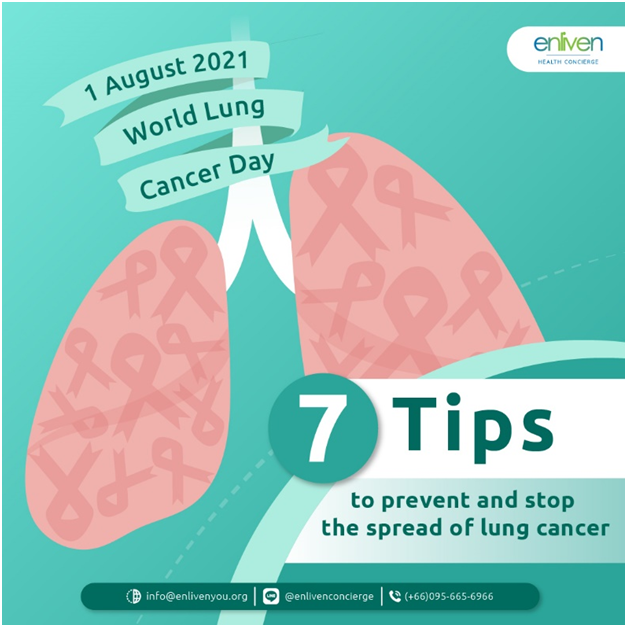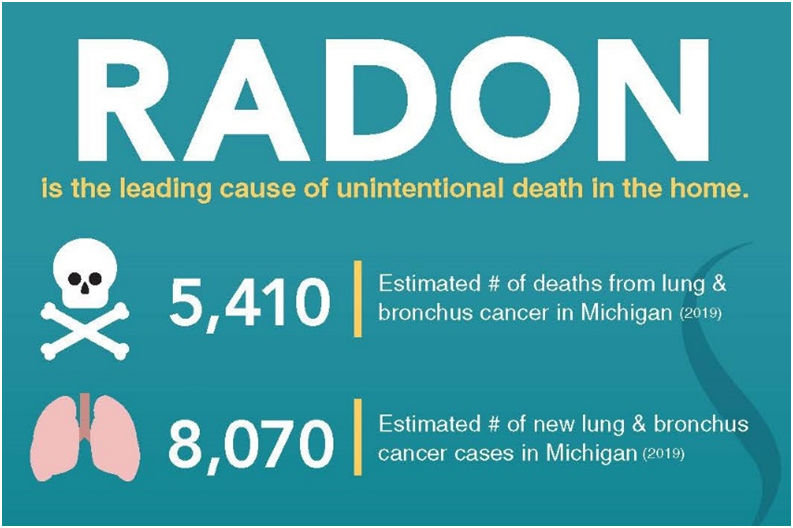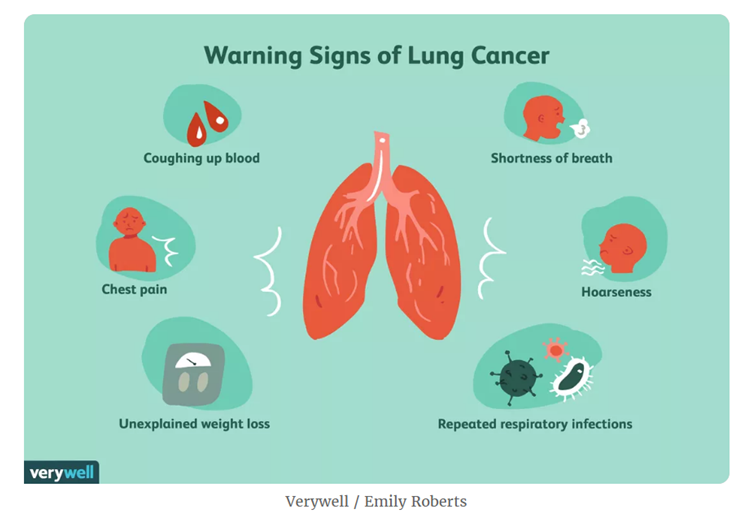– by Pirunrat Nathchayanonth (Yori), Client Coordinator
In recognition of World Lung Cancer Day, we are sharing easy ways for you to recognize the diseaseat the early stage.

“Lung cancer is cancer that forms in tissues of the lung, usually in the cells that line the air passages. It is the leading cause of cancer death in both men and women. There are two main types: small cell lung cancer and non-small cell lung cancer. These two types grow differently and are treated differently.”-Medline Plus (National Library of Medicine)
I know that many people, like me, when we talk about Lung cancer we normally and oftentimes thing about heavy smokers or second hand smokers, but believe it or not, those are not the only causes for this.
So what are other factors that can cause this kind of disease?
American Cancer Society – “Lung cancer in people who don’t smoke can be caused by exposure to radon, secondhand smoke, air pollution, or other factors. Workplace exposures to asbestos, diesel exhaust or certain other chemicals can also cause lung cancers in some people who don’t smoke.
A small portion of lung cancers develop in people with no known risk factors for the disease. Some of these might just be random events that don’t have an outside cause, but others might be due to factors that we don’t yet know about.
Lung cancers in people who don’t smoke are often different from those that occur in people who do. They tend to develop in younger people and often have certain gene changes that are different from those in tumors found in people who smoke. In some cases, these gene changes can be used to guide treatment.”
No worries if you’re not familiar with a few words in there. Read below to find out more about them

Radon is natural radioactive gas that comes from tiny amounts of uranium present in all rocks and soils. It can sometimes be found in buildings.
If radon is breathed in, it can damage your lungs, particularly if you’re a smoker. Radon gas causes a small number of lung cancer deaths in England.
Occupational Exposure and Pollution
Exposure to certain chemicals and substances which are used in several occupations and industries may increase your risk of developing lung cancer. These chemicals and substances include:
• Arsenic – a known human carcinogen associated with skin, lung, bladder, kidney, and liver cancer. A new study that replicates how humans are exposed to arsenic through their whole lifetime found that mice exposed to low concentrations of arsenic in drinking water developed lung cancer. The concentrations in the drinking water given to the mice were similar to what humans, who use water from contaminated wells, might consume.
• Asbestos – a fiber-like material that was once used in buildings for insulation, flooring and roofing. Its use has been fully banned in the UK since 1999.While asbestos can be dangerous, it’s not harmful if left alone. But if material containing asbestos is damaged, it can release a fine dust that contains asbestos fibers.When the dust is breathed in, the asbestos fibers enter the lungs and can gradually damage them over time.
• Beryllium – Direct contact with beryllium fumes or dusts may injure the exposed areas of the body, such as the eyes or the skin. Skin sensitization may also occur. Beryllium is also a known cancer-causing substance, with higher levels of lung cancer being reported.
• Cadmium – Highly toxic and exposure is known to cause cancer. It is primarily associated with human lung, prostate, and kidney cancers, and recently pancreatic cancer. It has also been associated with cancers of the breast and urinary bladder.
• Coal and Coke fumes – Coke oven emissions come from large ovens that are used to heat coal to produce coke, which is used to manufacture iron and steel. The emissions are complex mixtures of dust, vapors, and gases that typically include carcinogens such as cadmium and arsenic.
• Silica – Silica is a substance naturally found in certain types of stone, rock, sand and clay. Working with these materials can create a very fine dust that can be easily inhaled.Once inside the lungs, it causes swelling (inflammation) and gradually leads to areas of hardened and scarred lung tissue (fibrosis). Lung tissue that’s scarred in this way doesn’t function properly.
• Nickel – Skin complaints and respiratory effects have been reported from exposure to nickel. Studies have reported an increased risk of lung and nasal cancers from exposure to nickel refinery dusts and nickel subsulfide. Nickel compounds are classified as Group 1 carcinogen by the IARC, meaning they are carcinogenic to humans.
Research also suggests that being exposed to diesel fumes over many years increases your risk of developing lung cancer. One study has shown your risk of developing lung cancer increases by around 33% if you live in an area with high levels of nitrogen oxide gases (mostly produced by cars and other vehicles).
Signs and symptoms of lung cancer
Mayo clinic – “Lung cancer typically doesn’t cause signs and symptoms in its earliest stages. Signs and symptoms of lung cancer typically occur when the disease is advanced.
1. A new cough that doesn’t go away
2. Coughing up blood, even a small amount
3. Shortness of breath
4. Chest pain
5. Hoarseness
6. Losing weight without trying
7. Bone pain
8. Headache

Risk factors for lung cancer
The American Lung Association says that men who smoke are 23 times more likely to develop lung cancer than nonsmokers. However, lung cancer in never-smokers is the seventh most common cancer worldwide.
Although lung cancer is the leading cause of cancer death among men and women in the United States, female smokers appear to be at increased risk. After controlling for the number of cigarettes smoked, female sex imparts a significant, independent risk for most histologic types of lung cancer.

Most people diagnosed with lung cancer are 65 or older; a very small number of people diagnosed are younger than 45. The average age of people when diagnosed is about 70. Lung cancer is by far the leading cause of cancer death among both men and women, making up almost 25% of all cancer deaths.
If you are in doubt about your health, we strongly suggest that you have your health checked on regular basis and consult your doctor about this. If you have family history of cancer, or suspect that you are in high risk category, our partner also offers genetic screening as well. And if you don’t know where to start, drop us a message or email,we’re more than happy to assist😊
References
https://medlineplus.gov/lungcancer.html
https://www.mayoclinic.org/diseases-conditions/lung-cancer/symptoms-causes/syc-20374620
https://www.cancer.org/cancer/lung-cancer/causes-risks-prevention/what-causes.html
https://www.nhs.uk/conditions/lung-cancer/causes/
https://www.nhs.uk/conditions/asbestosis/
https://www.nhs.uk/conditions/silicosis/
https://www.niehs.nih.gov/health/topics/agents/arsenic/index.cfm
https://www.ccohs.ca/oshanswers/diseases/beryllium.html
https://roadmaponcarcinogens.eu › nickel
https://www.michigan.gov/egle/0,9429,7-135-3312_4120_4196-11722–,00.html
